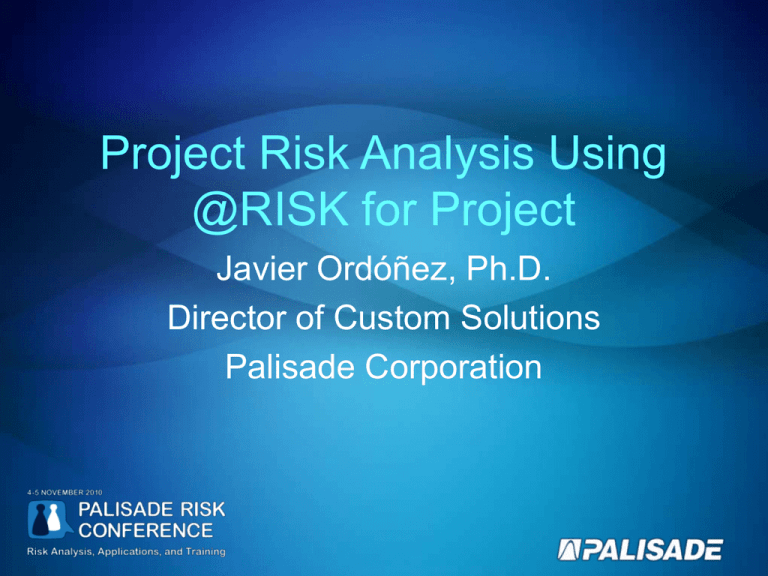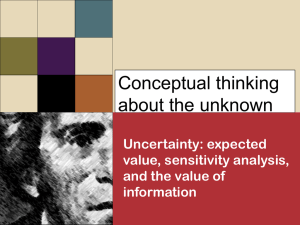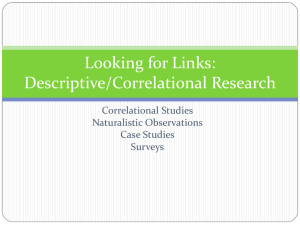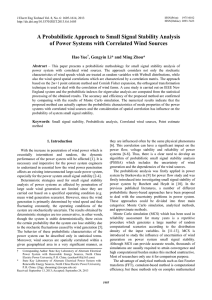Project Risk Analysis Using @RISK for Project Javier Ordóñez, Ph.D.
advertisement

Project Risk Analysis Using @RISK for Project Javier Ordóñez, Ph.D. Director of Custom Solutions Palisade Corporation Agenda » Background » @RISK for Project » What is coming!!... The new @RISK for Project Background: PRA Adoption in Federal & State Agencies » Federal Transit Administration (FTA) requires a risk assessment/mitigation study for any new transit project applying for federal funding » Department of Transportation of the State of Washington (WSDOT) has a risk-based approach to validate cost estimates » OMB Capital Programming Guide, 2007: Risk Adjusted Budget and Schedule (ANSI/EIA Standard – 748) » DoD Integrated Master Plan and Integrated Master Schedule Preparation and Use Guide: Schedule Risk Analysis » Risk Management Guide for DoD Acquisition (2003) Definitions: Project Risk & Uncertainty » Project risk is defined as the possibility that the outcome of an uncertain event affects negatively or positively the cost and time performance of project activities and/or their planned execution Risk = Consequence x Probability of Occurrence » Uncertainty is defined as the lack of knowledge about the parameters that characterize the system Probability Risks Events vs. Uncertainty $ o Time Uncertainty Risk Events’ Impacts Qualitative Risk Analysis Likely 3 High Likely 4 Near Certainty 5 5 2 Descript ion Activities Affected 4 Low Likelihood Priority 3 1 1 2 Not Likely Risk Register … Cost / Time Impact 1 Score Likelihood Likelihood n 1 2 3 4 5 Consequence Schedule Cost Technical Score Minimal or no impact Minimal or no impact Minimal or no impact 1 Additional activities required; able to meet key dates Budget increase <1% Minor performance shortfall, same approach retained 2 Minor schedule slip; will miss need date Budget increase <5% Moderate performance shortfall, but workarounds available 3 Project critical path affected Budget increase <10% Unacceptable, but workaround available 4 Cannot achieve key project milestone Budget increase >10% Unacceptable, no alternatives exist 5 Project Risk Analysis » Schedule Risk Analysis: • Quantification of uncertainty in activity durations • Quantification of uncertainty in project duration • Allocation and management of contingencies » Simulation: • Overcome the limitations of CPM/PERT • Generates scenarios involving a random set of durations. Each scenario produce a deterministic CPM deterministic schedule. • At the end, analyze the results of the scenarios to understand the range of variability in project duration • It requires activity information and distributions • Can model correlations among activities’ durations • Can obtain information of how critical is an activity • Can make use of probabilistic or conditional branching Simulation Results CPM Date Most Likely Completion Date CPM Date 80% Likely Other @RISK tools that help creating a risk analysis model » Parameter Entry Tables and Risk Categories » Probabilistic Branching and If/Then conditions » Using Global Variables (Event simulation) and Probabilistic Calendars for added realism (accuracy) The new version of @RISK for project Parameter Table & Risk Categories » Helps to quickly create risk analysis models – Useful when schedule has a large number of activities Probabilistic Branch Success Branch Failure Branch Conditional Branching » Model decisions or possible outcomes, e.g. permit does not get approved and that delay will affect project costs Global Variables and Event Simulation (Risk Registers) » Use EnableWhen function: • Duration=RiskTRIANG(4, 5, 8, EnableWhen(Variable[Event1]=1)) • Duration=RiskTRIANG(2, 5, 9, EnableWhen(prob=0.5))) Project Budgeting » Typically budgets are deterministic » Simulation Approach • Individual cost components are unimodal and skewed • Common use of 3 point estimate and triangular, beta, lognormal distributions • Model cost items prone to variation with suitable statistical distributions • Generate random numbers hundred of times according to specified distributions and calculate total cost • Total cost dist is used to calculate probability of cost overrun and to establish adequate contingencies Correlation Effects on Schedule S-Curve for Correlated and Not Correlated Durations 1.0 0.9 0.8 0.7 0.6 0.5 0.4 0.3 0.2 0.1 0.0 Not Correlated Date 3/1 2/16 Project Duration 2/2 1/20 1/7 12/24 12/11 11/27 11/14 Correlated 11/1 Prob Value <= Value on X-Axis Correlated vs. Independent Case Cost Correlation Issues » If correlation is ignored the total cost variance is underestimated » Data limitations during planning stages of most engineering projects » Correlation between variables makes use of historical data or subjective estimation from experts » Relationship between variables are shaped by many uncontrollable factors, and are best at subjective estimates based on experience and judgment » PDF that cost estimator specifies is the marginal distribution of that cost item; if cost items are correlated, the joint density function of the cost items needs to be calculated Cost Schedule Integration Project cost and schedule estimates are often disconnected. i.e.: If schedule is too optimistic the cost is underestimated » When the risk of schedule is disregarded in estimating cost risk, cost risk is underestimated Costo Cost » Periodo Actual Report Date Tiempo Time Cost Methodology » Use WBS » Non-biased quantification of cost elements: local uncertainty » Model correlation or avoid stochastic dependencies by applying generic risks » Include internal and external risks, and fixed and variable Traditional Modified for integrated analysis Integrated Risk Analysis Results Contingency calculation w/o PRA » The percentage figure is, most likely, arbitrarily arrived at and not appropriate for the specific project. » There is a tendency to double count risks because some estimators are inclined to include contingencies in their best estimate. » A percentage addition still results in a single-figure prediction of estimated cost, implying a degree of certainty that is simply not justified. » The percentage added indicates the potential for detrimental or downside risk; it does not indicate any potential for cost reduction and may therefore hide poor management of the execution of the project. » Because the percentage allows for all risk in terms of a cost contingency, it tends to direct attention away from time, performance, and quality risks. » It does not encourage creativity in estimating practice, allowing it to become routine and mundane, which can propagate oversights.









